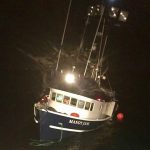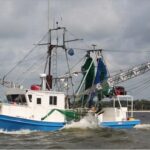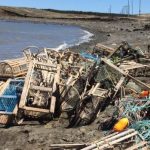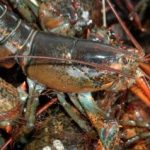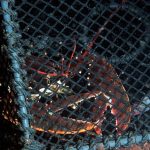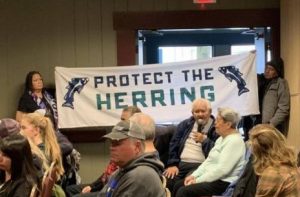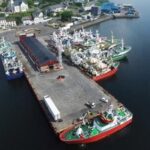Tag Archives: seals
The Long Haul, Part 4 – Protected Seals Raise Many Questions
In years past, seal hunters received a bounty of five dollars a nose to keep the population in check. Now, seals are federally protected, and their numbers have been steadily rebounding, with many thousands now living in local waters year-round. They’ve become a major tourist attraction, but local fishermen see the seals as just another threat to their livelihoods. continued@wcai
Prey, Predator Doesn’t Equal Cause, Effect
![]() On the surface it seems like a simple and straightforward equation: more seals equals more great white sharks. The connection, however, is likely far more complicated. continued@vineyardgazette
On the surface it seems like a simple and straightforward equation: more seals equals more great white sharks. The connection, however, is likely far more complicated. continued@vineyardgazette
From the Moderator – The contentious issue of seals, marine mammal population’s and public comment ignorance.
Posting link’s to story’s for fisherynation.com viewer’s today, and over the past few day’s, some issues stand out and I thought I’d address them. These are my opinion’s, and mine only. If you agree, or disagree, you have an opportunity to present your opinion. Submit them through the contact, located on the blue menu bar, and they will be featured. Keep it civil, and on point, please, with no insults or vulgar language. During the week, I posted three articles about “Study shows depleted fish stocks can come back from the brink”, with the claim cod will never recover in Canada because,, continued
Nearly 15,000 seals fill Cape Cod’s beaches as the sea mammal’s population explodes
 Nearly 15,000 seals have been drawn to the beaches of Cape Cod, sunning themselves on the New England shores. Aerial pictures of the coast show the sea mammals covering the area in brown. continued
Nearly 15,000 seals have been drawn to the beaches of Cape Cod, sunning themselves on the New England shores. Aerial pictures of the coast show the sea mammals covering the area in brown. continued
More Seal Issues from the other side – Grey seals robbing Danish fishermen of their livelihood
FishUpdate.com – From southern Zealand it is reported that 60-70 per cent of the cod is now either being torn out of the nets by seals or they are being mutilated, which means they cannot be landed or sold. In other places up to 30 per cent of the cod is being bitten or mutilated. continued
Too many seals?
![]() In 1991, researchers counted six seal pups on Muskeget Island just northwest of Nantucket. In 2007 they counted 2,096. That, in a nutshell, describes the trigger for this past Saturday’s Outer Cape Seal Symposium. More than 200 scientists, fishermen, and other people involved in coastal activities gathered at the Chatham High School auditorium to learn, share, and work on a process for dealing with what can, at times, seems like a fish-eating flippered invasion. continue reading
In 1991, researchers counted six seal pups on Muskeget Island just northwest of Nantucket. In 2007 they counted 2,096. That, in a nutshell, describes the trigger for this past Saturday’s Outer Cape Seal Symposium. More than 200 scientists, fishermen, and other people involved in coastal activities gathered at the Chatham High School auditorium to learn, share, and work on a process for dealing with what can, at times, seems like a fish-eating flippered invasion. continue reading
Seal Problems Everywhere! Fishermen want cull of New Zealand fur seals around the Coorong Lakes area
“If these populations continue to increase at the levels they have been, the impact on the broader ecosystem will be such that something will need to be done,” Goolwa Pipi Harvest Association chair Roger Edwards said.
“We harvest other native species like kangaroos.
“If the species is not under threat and it is having an impact and there is a viable market, then why should it not be harvested?
Cape Cod’s fishermen fret over seals, dogfish and the future
Two areas, 35-miles south and 150-miles east of Chatham have been closed for cod and other groundfish but the National Marine Fisheries Service is contemplating re-opening to help fishermen because all fishermen are facing drastic cuts of 70 percent in cod and 73 percent in haddock on Georges Bank. But not all fishermen are enthused.
Then there’s this insight by someone who can’t be very smart.
Wholesaler Andy Baler of the Nantucket Fish Company noted that huge mid-water trawlers are catching tons of herring off shore while the National Marine Fisheries Service looks idly on. “Cod and haddock feed on local herring but they’re starving. That’s why you see fish so skinny,” he said. “The mid-water trawlers are going to suck every bit of bait out there. You have one management system for some fish and another management system that goes and kills all the fish they eat.” Bullard conceded the two plans are un-connected. NOAA takes a fish by fish approach. “This port is crushed. We’re living on a few dogfish,” Baler declared. “We need some help. Keep the herring here so we can fish the channel.”
Read more: Cape Cod’s fishermen fret over seals, dogfish and the future – – Harwich Oracle http://www.wickedlocal.com/brewster/newsnow/x1826353094/Cape-Cods-fishermen-fret-over-seals-dogfish-and-the-future#ixzz29O2eBrZ9
The relationship is this. The larvae of the bottom fish need to go to the surface of the ocean in order to obtain food – plankton – and light. While they go up, they become a feast for the pelagics. When those larvae that survive become codlThe relationship is this. The larvae of the bottom fish need to go to the surface of the ocean in order to obtain food – plankton – and light. While they go up, they become a feast for the pelagics. When those larvae that survive become codlings, they want to go back to their friends and relatives. While they descend to their native habitat, they become a second feast for the pelagics.
http://carmine3.newsvine.com/_news/2010/11/04/5408211-fish-and-future


































